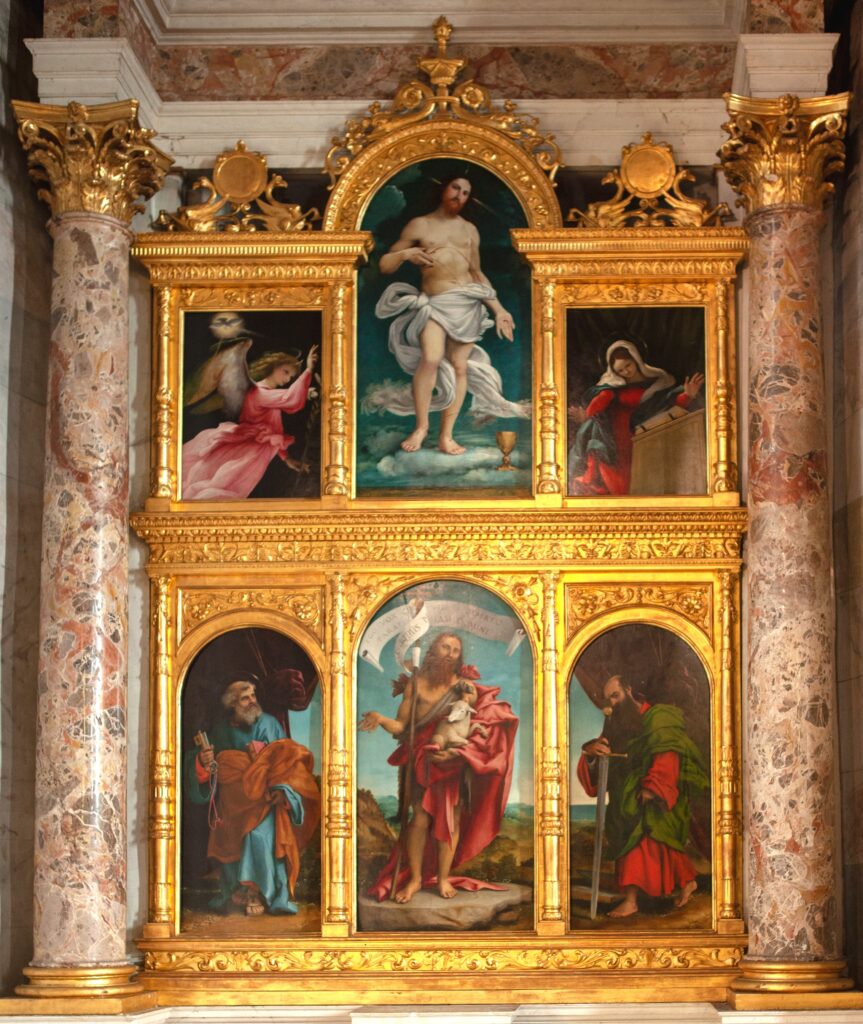Polyptych of Ponteranica, 1522
oil on wood, 270 × 140 cm
Ponteranica, church of Saints Vincenzo and Alessandro

Lorenzo Lotto was commissioned to paint the Polyptych by the local Corpus Christ school, a company of laymen devoted to works of charity. The congregation’s worship of the body of Christ explains the predominant iconography of the triumphant Christ, transfigured and bearing on his forehead the bleeding wounds of his sacrifice and the crown of thorns, while the blood gushing from his stigmata fills the chalice at his feet. In the middle panel of the lower register, St. John the Baptist exhibits the lamb with an open wound on its belly, again a symbol of Christ’s sacrifice; the two title blocks placed on the cross and above the Baptist’s head again exalt the Christological martyrdom at the redemption of humanity.
Formerly, the polyptych was placed in the school altar dedicated to the Body of Christ and the two St. Johns (the Baptist and the Evangelist) inside the church, while today it is leaning against the right side of the chancel. Being signed and dated 1522, we are faced with an anachronistic choice in the use of the polyptych (the system of depiction divided into individual panels joined in a single frame: in those years the altarpiece in a single solution had already established itself, but certainly the peripheral clients who ordered the polyptych from Lotto will have appreciated the respect for this traditional solution.
The massive and vigorous figures of the saints in the lower register, characterized by heavy robes composed of bright hues, are presented against the background of a single landscape to the eyes of the worshippers (in the two side panels a burgundy-colored drape is opened as a curtain): to enable the believers of the time to identify more spiritually with prayer, the saints, models of Christian virtue, bear their attributes prominently and are depicted with faces of absolute popular truth. A religious-figurative approach that would be taken up strongly in the art of the Counter-Reformation, above all, in the Bergamasque territories, by Giovan Battista Moroni, who was always linked to the models of Lorenzo Lotto, as much in his altarpieces as in his portraits.
The detail that remains unforgettable in the eyes of the observer, certainly the most successful and sensational of the whole polyptych, is the panel with the Archangel Gabriel which, in the upper score, composes the Annunciation together with the Marian pendant. Shaken by the wind-breath of the Holy Spirit, personified by the dove in the background, the divine messenger, very elegant, diaphanous and unreal, is characterized by a refined and intense coloristic research, all played on an infinite range of pinkish shades, obtained through a skillful play of preparatory glazes spread with white lead. A series of elements that also led Bernard Berenson (a great scholar of Lorenzo Lotto) to call it among the most beautiful angels of the Renaissance.
- Opening time : M-F 08.00 -18.00
S-S 08.00 – 18.00 - Telephone: +035571867
- E- Mail: Contact us